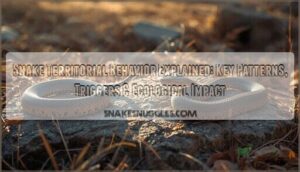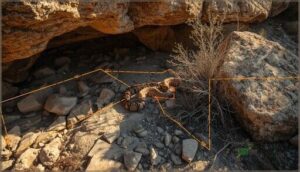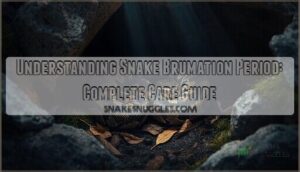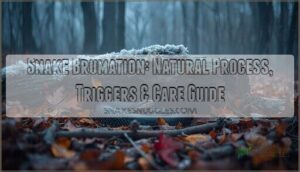This site is supported by our readers. We may earn a commission, at no cost to you, if you purchase through links.
Most snakes slip through their world without fanfare, but a select few stage fierce, invisible contests over patches of sun-warmed earth and silent, musty burrows. True territoriality in snakes might seem rare—a blip in vast patterns of solitary hunting—yet where the balance tips, nature puts on a clinic in resource management.
Season by season, chemical trails anchor rivalries and reunions, each movement mapped with a logic shaped by survival. Once you understand how snake territorial behavior plays out, every twist in the grass starts to look deliberate, shaped by needs older than you can imagine, and every silent standoff holds the keys to a deeper ecological story.
Table Of Contents
- Key Takeaways
- What is Snake Territorial Behavior?
- How Snakes Establish and Mark Territories
- When and Why Snakes Become Territorial
- Aggression, Defense, and Territorial Disputes
- Ecological and Evolutionary Roles of Territoriality
- Conservation Implications of Snake Territoriality
- Frequently Asked Questions (FAQs)
- Conclusion
Key Takeaways
- True territoriality occurs in fewer than 5% of snake species and emerges only where the fitness benefits of defending specific resources—like thermal shelters, food clusters, or nesting sites—outweigh the high energetic and injury costs of aggressive defense.
- Snakes establish and communicate territorial boundaries primarily through chemical cues and pheromones rather than vocal or visual displays, with scent marking intensity peaking during the spring breeding season when hormonal changes drive aggressive interactions and mate competition.
- Territorial behavior carries measurable survival costs, including up to 25% mortality in dominant males during peak seasons, physical injuries from combat, increased disease transmission, and reduced growth rates that directly impact reproductive success across populations.
- Habitat loss and fragmentation severely disrupt snake territoriality by creating migration barriers that reduce gene flow by up to 41%, leading to decreased genetic diversity, isolation of populations, and behavioral shifts that threaten long-term species survival and require conservation strategies focused on maintaining habitat connectivity.
What is Snake Territorial Behavior?
Snake territorial behavior is shaped by a mix of instincts, environment, and resource needs. Different species show unique patterns in how they claim space.
Here’s a look at specific enclosure options that support these natural behaviors.
Definition and Key Concepts
When you hear the term “territorial behavior” in snakes, picture the active defense of a specific space to secure key resources—food, shelter, or a breeding site. True snake territoriality is rare, unfolding where resource defense offers clear fitness benefits.
This behavior relies on a cost-benefit balance that favors energy spent on exclusion, yielding site fidelity and shaping unique patterns in snake behavior. Studies often use kernel density estimations to understand reptile spatial ecology.
Territoriality Across Snake Species
Snake territorial behavior is the exception rather than the rule, with less than 5% of snake species demonstrating true territoriality. Across habitats, you’ll find striking contrasts:
- Females defending sea turtle nests
- Males fighting for thermal shelters
- Resource defense shaping aggression styles
- Geographic variation driving who holds ground
- Population impact seen through territory-linked gene flow
Each scenario reflects custom evolutionary adaptations within specific snake habitats and ranges. This can impact sex-specific survival rates, influencing population dynamics.
How Snake Territoriality Differs From Other Animals
While a handful of snakes defend resources, most rely on solitary predation and rarely show the classic territoriality seen in mammals and birds. For instance, you won’t find snakes marking boundaries with sound or scent like wolves or songbirds. Aggression costs run high, making prolonged defense impractical. Evolutionary differences in animal behavior shape how snakes interact within ecological niches and manage species interaction.
| Marking Mechanisms | Aggression Costs | Resource Defense |
|---|---|---|
| Chemical cues | Injury risks | Food clusters |
| Minimal scent | Survival impact | Shelter sites |
| No vocal signals | Reduced longevity | Seasonal eggs |
How Snakes Establish and Mark Territories
Snakes have their own ways of claiming space and making their presence known. These methods can shift with the seasons and depend on the resources available.
Here’s what you’ll see when snakes set up and mark their territories.
Chemical Cues and Pheromone Signaling
Ever wondered how snakes stake their claim without a sound or a scuffle? Chemical signals and pheromones are their secret language. Through scent marking and complex pheromone composition, you’ll find snakes using behavioral metrics like tongue-flicking to gauge territory. Hormonal influence drives seasonal changes in chemical communication, shaping:
- Scent discrimination
- Pheromone signaling
- Intraspecific boundaries
- Mate recognition
- Territorial defense
Physical Markers and Boundary Definition
Across rugged slopes and tangled shrubs, you’ll notice how territorial behavior in snakes relies on physical cues as much as scent marking. Hibernacula features—like stable talus slopes—anchor communal dens, while refuge geometry and vegetation anchors define territorial ranges.
Shelter fidelity is strong; snakes revisit the same burrows, using landscape constraints and distinctive home range boundaries to weave a subtle map of space and belonging.
Seasonal Patterns in Territory Marking
As winter fades and temperatures climb, you’ll notice snake territorial behavior ramping up—driven by seasonal adaptation. Pheromone production surges, marking territorial ranges most intensely around breeding peaks in spring.
Activity shifts follow environmental influences; movement and scent marking spike, then wane as dormancy suppression sets in. During breeding season, territorial behavior is at its height, only to contract sharply when colder months force snakes into inactivity.
When and Why Snakes Become Territorial
Snakes don’t become territorial all the time—it’s a response to certain needs and changing conditions. You’ll notice this behavior most when breeding, searching for resources, or conserving energy.
Here are the main situations where territorial instincts kick in.
Breeding Season and Hormonal Triggers
When breeding season arrives, snakes shift gears—testosterone influence sparks seasonal aggression, driving intense mating competition. You’ll notice males expanding their ranges, seeking mates, and engaging in territorial disputes. Hormonal plasticity means these behaviors ramp up when reproductive output is at stake, then fade as hormone levels drop.
For females, aggression peaks only when nesting resources are present, tightly linking hormonal changes to reproductive success.
Resource Availability and Habitat Selection
How do snakes decide where to stake their claim? It’s all about resource allocation—territorial behavior intensifies where prey abundance is highest and habitat heterogeneity offers diverse ecological niches.
Microhabitat selection shapes survival rates, as snakes compete for prime spots. Habitat selection shifts with resource competition, and anthropogenic impact, like habitat fragmentation, can force snakes to adapt, altering their territorial patterns and long-term population health.
Energy Conservation and Survival Strategies
Imagine surviving months with barely a meal—your body becomes a master of energy conservation. Metabolic Rate reduction lets snakes endure scarcity, while Hibernation Strategies allow communal denning for up to eight months. Non-Feeding Growth means they can lengthen even when starving.
Foraging Adaptations and size-dependent Survival Rates shape territorial behavior, ensuring the strongest individuals persist through lean seasons and unpredictable environments.
Aggression, Defense, and Territorial Disputes
Territorial disputes among snakes can take many forms, from subtle warnings to open confrontation. These behaviors come with real risks and consequences for the snakes involved.
Here’s what you need to know about the main ways snakes handle aggression and defense.
Types of Territorial Interactions
Ever wondered how territoriality in snakes unfolds? You’ll encounter a fascinating range of interactions:
- Physical Aggression—biting, wrestling, and combat injuries mark intraspecies competition.
- Threat Displays—body flattening and mock strikes often precede fights.
- Chemical Interference—scent marking deters rivals from entering territories.
- Mate Competition—aggressive encounters spike during breeding, fueling territorial disputes.
Each behavior shapes aggression and defense strategies in territorial snakes.
Costs and Risks of Territorial Aggression
Aggression in territorial disputes carries serious survival costs. Physical injury and increased disease transmission often follow combat, with dominant males facing up to 25% mortality in peak seasons.
Energetic costs spike, reducing growth and reproductive success. Habitat loss and resource competition drive displacement, further exacerbating these challenges.
Conservation costs climb as territorial behavior makes snakes harder to monitor, ultimately impacting population stability and biodiversity efforts.
Species-Specific Defensive Behaviors
Physical risks and energetic costs are only part of the story—territorial defense varies widely among snake species. Hood flaring in King Cobras, venom spitting from spitting cobras, and muscular defenses in boa constrictors represent aggressive behavior shaped by threat context.
Death feigning and mimicry strategies, like those seen in hognose snakes, highlight how snake behavior adapts for territorial defense without direct confrontation.
Ecological and Evolutionary Roles of Territoriality
Territorial behavior shapes how snakes interact with their environment and each other. It influences everything from where they find food to how their populations change over time.
Let’s look at the main ways territoriality plays an ecological and evolutionary role.
Resource Allocation and Ecological Niches
Resource allocation shapes the ecological niches snakes carve out across diverse habitats. Your understanding of snake territoriality and behavior hinges on four main factors:
- Niche Partitioning through dietary diversity, which limits direct competition.
- Habitat preferences guiding habitat selection and resource allocation.
- Adaptive radiation driving rapid shifts in resource use.
- Intraspecific resource competition, influencing survival and specialization within populations.
Effects on Population Dynamics and Gene Flow
As snakes secure their place within an ecosystem, their territorial behavior shapes population dynamics in subtle but significant ways. Migration barriers and habitat fragmentation reduce gene flow, leading to lower genetic diversity.
When connectivity is lost, risks like genetic drift and inbreeding depression threaten a population’s adaptive potential. Conservation depends on restoring these pathways, ensuring populations remain resilient and capable of weathering environmental change.
Evolutionary Advantages and Adaptations
When concentrated prey allows, resource defense shapes snake behavior, fostering evolutionary advantages like phenotypic plasticity and sex-specific survival. Morphological adaptations—such as changes in body or jaw size—arise in response to territory-specific pressures.
Territoriality promotes competitive exclusion, letting dominant individuals secure resources and specialize. In reptile ecology and evolutionary biology, these layered responses guarantee survival amid shifting environments and underline the complexity of snake evolutionary adaptations.
Conservation Implications of Snake Territoriality
Understanding how snakes use and defend their space is critical when planning for their protection. Territory shapes everything from where snakes can thrive to how they interact with their environment.
Let’s look at the main ways territory impacts conservation choices for these unique reptiles.
Impact of Habitat Loss and Fragmentation
Imagine losing your familiar neighborhood overnight—that’s the reality for many snakes facing habitat loss and fragmentation.
For many snakes, habitat loss and fragmentation means suddenly facing a world where familiar territory disappears overnight
The effects of habitat loss ripple through populations: declines become inevitable, movement patterns grow erratic, and territory suitability plummets. Gene flow is disrupted, isolation rises, and behavioral shifts like increased aggression emerge.
Put simply, fragmentation alters every facet of snake territoriality, pushing some species toward the brink.
Territoriality and Conservation Strategies
When you think about effective conservation, you can’t ignore territoriality or its ties to population dynamics and behavioral ecology. Conservation plans are now weaving habitat connectivity into species management, pushing for protected areas that actually reflect snake territories.
Human impact and climate change add layers of complexity, but targeted expansion and smart placement of these protected areas help safeguard critical habitats, supporting long-term survival.
Research Directions in Snake Behavioral Ecology
Understanding how to advance research directions in snake behavioral ecology means you’ve got to weave together technology and fresh thinking. With enrichment techniques revealing behavioral plasticity, refining physiological thresholds for different species, and expanding sensor technology, you’re better poised to spot key behavioral indicators.
True progress in Snake Behavior and Ecology relies on:
- Improved Ecological Research Methods
- Global coordination of field efforts
- Data-driven adaptation of conservation strategies
Frequently Asked Questions (FAQs)
Do snakes return to the same territory each year?
Like clockwork, many snakes display considerable site fidelity, returning year after year to reuse hibernacula and core habitat patches.
This homing instinct shapes migration patterns, stabilizes home ranges, and ensures access to resource hotspots across changing seasons.
How does territoriality impact snake social structure?
Territorial behavior shapes snake social hierarchy and group cohesion by promoting resource defense, influencing mating competition, and driving kin selection.
These dynamics form the backbone of snake social behavior, integrating animal behavior concepts within behavioral ecology and species interaction frameworks.
Can juvenile snakes establish their own territories?
Juvenile snakes rarely establish territories. Instead, they display dispersal patterns and low site fidelity, relying on adult tolerance within resource-rich areas.
Resource competition remains minimal until growth rates push them toward independence and survival strategies shift.
What role do predators play in shaping territories?
Predators reshape territory size, habitat selection, and species interactions profoundly. You’ll notice snakes reduce territorial ranges by up to 41% in high-risk areas, favoring dense cover while adjusting survival strategies to minimize exposure and maintain population structure.
How does climate change affect snake territorial ranges?
Climate change is driving range contraction and species redistribution in snake populations. Habitat fragmentation intensifies as thermal zones shift, forcing community turnover.
You’ll see altered territorial behavior, changing ecological niches, and emerging public health risks from environmental factors.
Conclusion
Without this foundation in snake territorial behavior, you’d misread every coiled sentinel, every scent trail, every silent showdown as random chance instead of calculated strategy.
Each territorial marker you now recognize carries survival data refined across millions of years—proof that even limbless hunters play the long game.
When habitat vanishes, so do these ancient rhythms, and your understanding becomes the first step toward protecting the invisible contests that keep ecosystems balanced and functional.
- https://pmc.ncbi.nlm.nih.gov/articles/PMC9913663/
- https://onlinelibrary.wiley.com/doi/abs/10.1111/geb.13225
- https://journals.plos.org/plosone/article?id=10.1371%2Fjournal.pone.0160033
- https://www.sciencedirect.com/science/article/abs/pii/S0006320797000323
- https://www.africansnakebiteinstitute.com/news/newsletters/on-territories-and-home-ranges/














